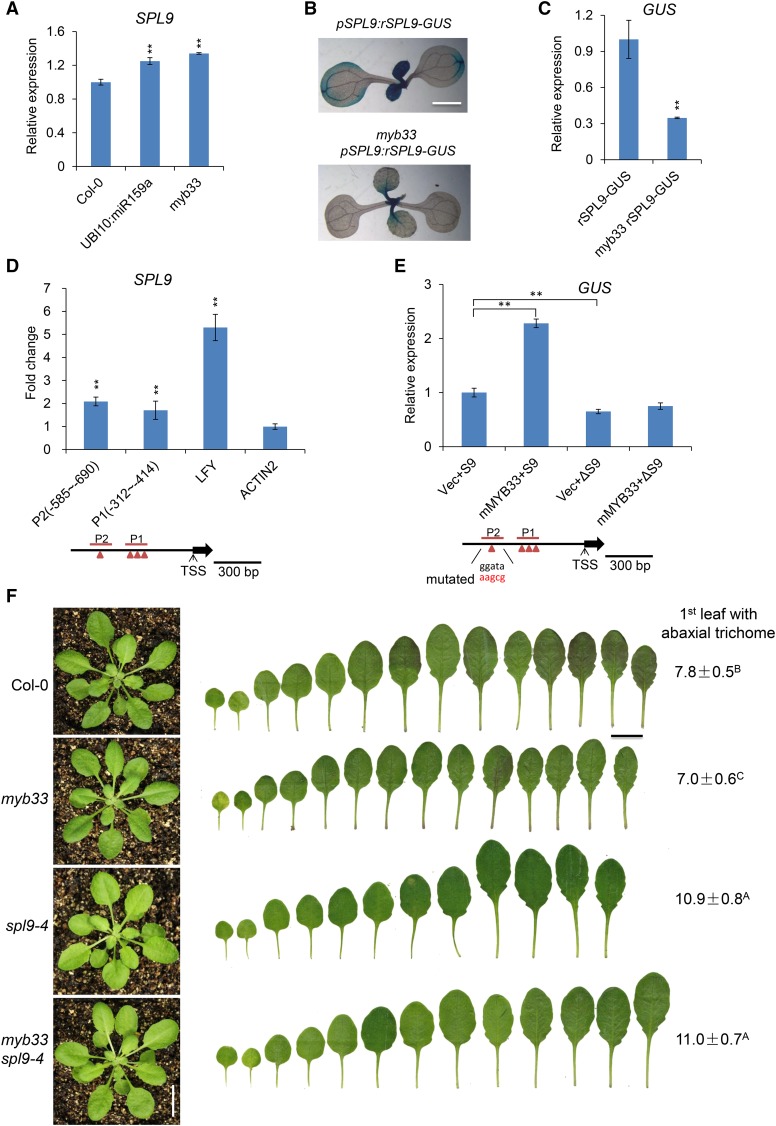Figure 4.
MYB33 Directly Regulates SPL9 Expression.
(A) The expression level of SPL9 in 10-d-old Col-0, UBI10:miR159a, and myb33 seedlings grown in short days. Values are the means of three biological replicates. Asterisks indicate significant difference from Col-0 using Student’s t test (P < 0.01).
(B) GUS staining analyses of 10-d-old pSPL9:rSPL9-GUS and myb33 pSPL9:rSPL9-GUS plants grown in short days.
(C) Quantitative qRT-PCR analysis of GUS expression in 10-d-old pSPL9:rSPL9-GUS plants in Col-0 and myb33 backgrounds grown in short days. Asterisks indicate significant difference from rSPL9-GUS using Student’s t test (P < 0.01).
(D) ChIP-qPCR analysis of MYB33 binding sites in the promoter of SPL9. Chromatin from 10-d-old pMYB33:3×FLAG-mMYB33-3′UTR and pMYB33:HA-mMYB33-3′UTR seedlings grown in short days was immunoprecipitated with a polyclonal antibody to FLAG. Primers surrounding the putative MYB33 binding sites in the SPL9 promoter region were designed upstream of the TSS of SPL9. Values are the means of three biological replicates, each having three technical replicates. P1 and P2 denote different PCR-amplified regions in the promoter region of SPL9. LFY was used as a positive control, whereas ACTIN2 was a negative control. Asterisks indicate significant difference from the value of ACTIN2 using Student’s t test (P < 0.01). Red triangles indicated the predicted MYB binding sites.
(E) Activation of SPL9 transcription by direct binding of MYB33 to the cis-regulatory sequence in the SPL9 promoter. GUS expression was quantified using qRT-PCR in leaves of N. benthamiana infiltrated with Agrobacterium with different combinations of constructs. pSPL9:GUS (S9), SPL9 transcriptional reporter construct; pΔSPL9:GUS (ΔS9), SPL9 transcriptional reporter construct with a mutated version of the cis-regulatory sequence to which MYB33 binds; UBI10:mMYB33, miR159-insensitive overexpression vector; pSY06, the control vector. Vec+S9 (pSY06 + pSPL9:GUS), mMYB33+S9 (UBI10:mMYB33 + pSPL9:GUS), Vec+ΔS9 (pSY06 + pΔSPL9:GUS), mMYB33+ΔS9 (UBI10:mMYB33 + pΔSPL9:GUS). Red letters indicate the mutated bases. Values were normalized to that of Vec+S9 and are the means of two biological replicates; asterisks indicate significant difference from Vec+S9 using Student’s t test (P < 0.01).
(F) spl9-4 is epistatic to myb33. Leaf shape and abaxial trichome phenotypes of Col-0, myb33, spl9-4, and myb33 spl9-4 in short days. Numbers indicate the first leaf with abaxial trichomes. Different capital letters indicate significant difference between genotypes using one-way ANOVA at P < 0.01(n = 20 plants, ±sd; Supplemental File 1). Bar = 1 cm.

